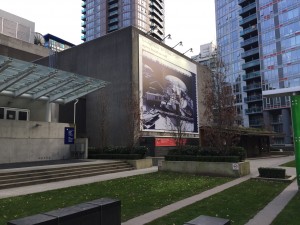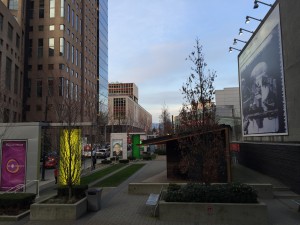Laiwan’s FOUNTAIN: THE SOURCE OR ORIGIN OF EVERYTHING
Laiwan’s FOUNTAIN: THE SOURCE OR ORIGIN OF EVERYTHING
hangs on the side of the CBC building in downtown Vancouver: just north-east of the intersection of Hamilton and Robson, directly across from the south-eastern facing of the Vancouver Public Library’s central branch. Directly next to the exhibition is small outdoor performance space. The piece participates in a project called The Wall (http://www.vancouverheritagefoundation.org/special-projects/the-wall/), which is “made possible by a unique partnership between Vancouver Heritage Foundation, JJ Bean Coffee Roasters, and the CBC,” according to a plaque installed below the artwork. A small coffee stand occupies the space in front of the installation.
The project (which includes an online element in the form of a website and an experimental public archive called the “image basin” – accessible at http://www.laiwanette.net/fountain/) is a meditation on what Laiwan calls “the metaphor of fluidity within the city’s built environment.” The image currently occupying The Wall is the centrepiece of Laiwan’s project, providing a visual anchor (in nautical vernacular) for the project’s discussion of the circulation and fluidity of the media. The image is a single frame from the 1956 film Summer Afternoon, which Laiwan chose from a plethora of images available to her during a residence at the CBC’s analogue media archives. Above the image an inscription reads: “hydrologic marsh / lotic & lentic & fen / mystery beneath our walk” – inspired (according to the project’s curator, Joni Low, whose curatorial essay can be found here: http://centrea.org/wp-content/uploads/2014/05/FOUNTAIN-brochure.pdf) by the provincial government’s “Glossary of Water Quality Terms.”
Laiwan’s web project highlights that curating images and text is now possible for a broad range of people, thanks to the internet and to increasing digitization of the media. Archives are no longer possible only in the institutional context, which brought its own set of problems; the act of creating an archive is now available to individuals as a way of expressing their own complex identity. This project celebrates this aspect of digital culture, because of which personal archives can develop and reflect individual identity, and in which images and text can now flow and circulate in a way that was never possible before.

Through what might seem to be an arcane choice of image and text, Laiwan evokes the complex nature of what can lie below a surface – whether the surface is an image, a text, or the concept of a person or a group of people. According to Low’s essay, the project pursues an “undoing of the rational, predetermined thinking that often informs the obsessiveness of data collection” – a type of thinking within which deeply problematic, inflexible ideas of a monolithic Canadian identity can thrive. Ultimately, Laiwan reveals not only the constant circulation and change which characterizes modern media culture, but also the fluid and composite nature of Canada’s population. Hers is a vision that calls attention to and celebrates the numerous diasporic identities which constitute the reality of Canadian culture – by encouraging a new outlook on the collection and sharing of media.
